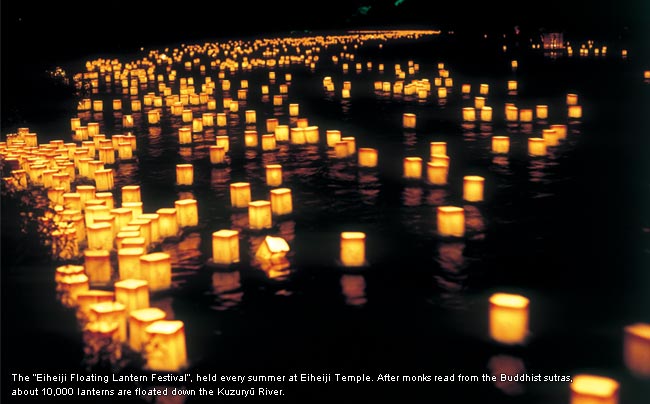
The Hokuriku Region is known for its deep religious beliefs and is referred to as the "Kingdom of Jōdō Shinshū Buddhism". Travelers to Hokuriku have the opportunity to observe innumerable traditions rooted in a history of religious beliefs.
Traditions Cultivated Through Faith
One thing which often surprises tourists when they walk through the Higashi Chaya District in Kanazawa is the ears of corn hanging from the eaves of houses.
The origin of this custom lies in the annual "46,000 Days Festival" held during the summer at the Temple of Kannon (Kannon-in) in Higashiyama, Kanazawa. Worshipers who visit the temple on this day are said to receive 46,000 days' portion of heavenly rewards from the Goddess Kannon. Visitors buy ears of corn that have been blessed with a prayer, and hang them on the eaves of their houses to cast out evil and attract good fortune. Corn with many kernels are said to symbolize prosperity and hairy husks are said to bring in profit or drive away demons.
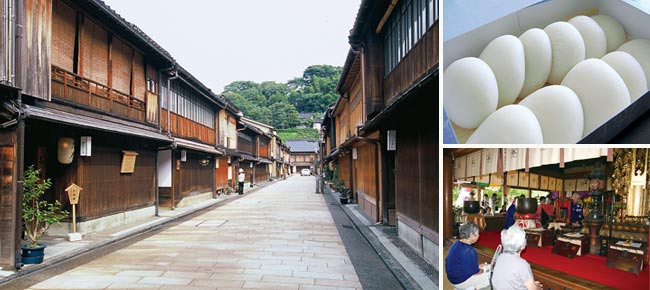
(Left) Higashi Chaya District is an area deeply rooted in religious beliefs; (Top Right) Korokoro mochi are not to be cut up or fried; (Bottom Right) The Temple of Kannon has been holding the "46,000 Days Festival" since the feudal era.
Another custom in Kanazawa is to decorate the ceiling with sliced mochi rice cakes on bamboo skewers. For more than 300 years, every spring and autumn, the Aburi-Mochi (grilled mochi) Ritual has been held at Shinmyōgū Shrine next to Uhōin Temple where writer Saisei Murou spent much time as a child. At this shrine, one can buy aburi-mochi, small, square-shaped rice cakes which are grilled on charcoal, placed on a bamboo skewer, then flavored with ginger and soy sauce. Plain mochi, which is sold at the same time, is said to cast out evil and avert disaster if it is pinned to the ceiling.
Mochi is said to drive away evil and bring good luck, and has been used for countless generations in numerous celebrations and rituals. In Kanazawa there is a custom where korokoro (rolling) mochi are delivered to the relatives and neighbors of a woman expecting a child. The word korokoro is used as good fortune for a safe delivery, expressing the hope that the child will simply "roll out of the mother". (In Toyama Prefecture, there is a similar custom.) The roundness and smoothness of mochi represents babies, and longer mochi are said to predict the birth of a boy, while a rounder one would predict the birth of a girl.
One can see that these customs which are deeply rooted in the lives of the Hokuriku people have been cultivated through the history of their religious beliefs.
The Amazing Size of "Ganmodoki"
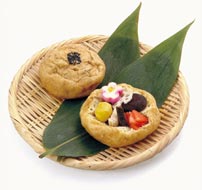
In Kanazawa, you can find these huge Ganmodoki (pictured is hirozu made from Kanazawa tofu).
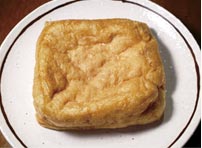
This dish of fried tofu is shaped like a floor cushion and is very popular in Fukui Prefecture.
Every November to December, Jōdo Shinshū temples all over Hokuriku hold a Buddhist ceremony called "Hō-on-kō", which commemorates and honors the virtues of the monk Shinran, the founder of the sect. During this time, ceremonial offerings of red bean soup, konjac, vinegared radish, and other vegetarian favorites of Shinran are prepared. Among these dishes is a dish called ganmodoki (known in Kanazawa as hirozu), which is made out of deep-fried tofu patties stuffed with gingko nuts, jelly ears, lotus root, shiitake mushrooms, and more. It often amazes tourists with its ample size. In the past, Hō-on-kō used to be a special day when everyone could eat to the fullest. Hirozu was no doubt a luxury which could only be afforded on a holiday like this.
Fukui Prefecture is ranked first in Japan for the consumption of fried tofu. It can be found not only in standard fried tofu dishes, but also in soba noodles and ramen noodles, as well as many other dishes. It also happens to be an indispensable element of Hō-on-kō rituals, proof of the deep religiosity of the people of Fukui.

(Left) Dishes offered up during the Hō-on-kō festival in Nanto City; (Center) A meal of hard tofu (which does not break apart even when bound up in straw); (Right) A ceremony at Hō-on-kō.
Building a Home With a Life Centered Around Beliefs
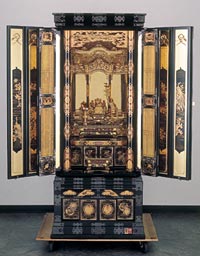
A Kanazawa Buddhist altar, which is also extremely valuable as a work of art.
In Hokuriku, many people are able to recite passages from the Buddhist text "Shōshinge", and for many of them, owning a resplendent Buddhist altar is a lifelong goal. This gave birth to the tradition of constructing very artistic Kanazawa Buddhist altars which are designed and decorated using gold leaf and lacquer techniques.
In traditional houses, the best room was usually not the living room or the guest room, but the room in which the Buddhist altar was kept. These rooms are designed so that by taking off the paper sliding doors, the room can be easily turned into a large open space that can accommodate many people for Buddhist rituals, similar to a temple hall. This shows how the people put their faith at the center of their lives. It brings a sense of nostalgia and warmth to the Hokuriku region because a visit here feels like a visit to the Buddhist altar room in your grandmother's house.
Places Where You Can Experience the Deep Faith of Hokuriku
Zuisenji Temple, located in Nanto City, which in ancient times used to be the center of Jōdō Shinshū Buddhism in Toyama, is decorated with the work of an artisan who is said to have been the founder of Inami Wood Carving.
If you walk around and explore the Utatsuyama Temple Area (also known as the Sanroku Temples) located at the foot of Mt. Utatsuyama in Kanazawa, you will find the labyrinth-like spiritual road called "Heart's Path" (kokoro no michi), home to a number of shrines and temples like the Temple of Kannon (Kannon-in), which we touched upon earlier.

(Left) Zuisenji Temple, the place said to be the birthplace of Inami Wood Carving; (Center) Every July, in the hall containing the statue of Prince Shotoku, a ceremony is held that honors the virtues of Prince Shotoku and commemorates his life;. (Right) View of Kanazawa from Hōsenji Temple, located in the Utatsuyama Temple Area.
At Eiheiji Temple in Fukui Prefecture, you can see many priests devoting themselves to ascetic practices. A visit to a place like this will make you understand just how deep the roots of faith in Hokuriku are.
Travelers to this region can feel the sincere faith of the land, as well as the peace of mind brought about by the tradition of centering one's life on faith. Keep that in mind when you visit this area, and you will feel the true beauty of Hokuriku, which you might not have noticed before.
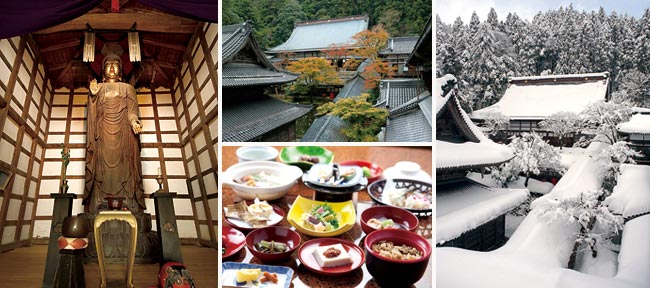
(Left)A statue of Gautama Siddhartha, this is one of the three great Buddhas of Kanazawa, located in Renshōji Temple. (Utatsuyama Temple Area); (Center Top) The changing colors of autumn foliage come to Eiheiji Temple; (Center Bottom) After you visit the temple, you can enjoy a vegetarian-style meal at the restaurants just outside the temple; (Right) In the winter, Eiheiji becomes enveloped in sub-zero temperatures.

